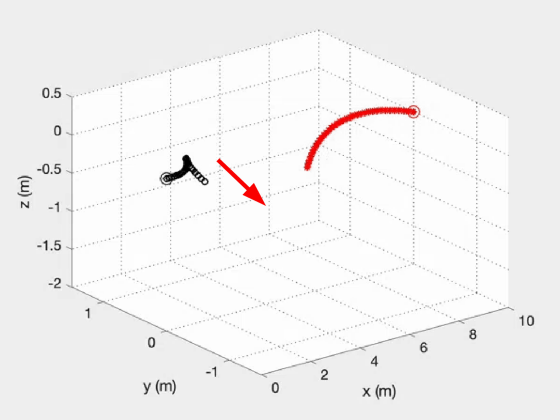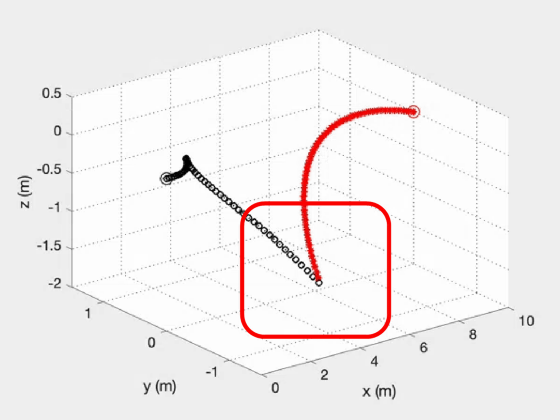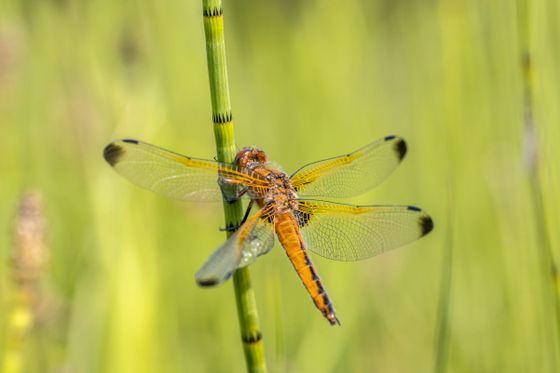What does it mean for researchers to develop AI for efficient missile interception to copy the 'dragonfly brain'?

When you hear AI, many people may have the impression that it is something that imitates the human brain or has performance that surpasses that of the human brain. However, Dr. Francis Chance , who works at Sandia National Laboratories in the United States, which conducts research on military science and security, is developing AI that models the 'dragonfly brain' instead of the human brain. ..
Fast, Efficient Neural Networks Copy Dragonfly Brains-IEEE Spectrum
https://spectrum.ieee.org/fast-efficient-neural-networks-copy-dragonfly-brains
It is said that the human brain has 86 billion nerve cells (neurons) in total, and it realizes various tasks that require advanced cognitive ability. On the other hand, insects have hundreds of thousands to one million neurons at most, but they are still very effective in specific tasks.
Dr. Chance, who is conducting research on national security, is aiming to design a missile interception system with reference to the 'dragonfly brain' with colleagues. 'It may be counterintuitive to look at dragonflies as a pioneer in future computer systems,' said Dr. Chance, who certainly has the image that AI mimics or surpasses human activity. Pointed out that is strong. However, developing sophisticated AI requires enormous processing power of high-performance computers, and the energy cost required for training also increases.
Dr. Chance said, 'But for artificial neural networks to be useful, do they really need to be big and complex? I don't think so. If you want to enjoy the benefits of a neuron-inspired computer in the short term, We need to strike a balance between simplicity and sophistication. ' In other words, AI that specializes in a specific function does not necessarily have the ability to match humans in all fields, so there is a need for an insect-like AI that can efficiently achieve goals with a simple neural network. That's why.

Dragonflies have an excellent ability to chase and catch prey while flying in the sky, and the prey that started chasing preys with a success rate of 95%, and eats hundreds of prey a day. Many researchers have been paying attention to the flight ability of dragonflies for a long time, and American institutions have also developed drones with reference to dragonflies, but Dr. Chance focuses on the 'brain' that dragonflies chase and catch prey. doing.
When chasing a prey, the dragonfly moves its body according to the movement of the opponent, and the speed at which the dragonfly reacts to the movement of the opponent is only 50 milliseconds. Considering the time it takes for the eyes to process visual information and then move muscles, the dragonfly's brain knows its prey and its location with only 3-4 layers of neurons, and finds an appropriate tracking path to move. Dr. Chance says.
If the system in which the dragonfly chases the prey can be reproduced with a neural network, it can be applied to an interceptor missile system that can calculate an appropriate trajectory without affecting the weight and power consumption of the missile. For private use, software for avoiding collisions of self-driving cars and autonomous drones, and small drones that track and repel disturbing insects can also be envisioned.

To mimic the dragonfly's brain, Dr. Chance built a three-layer neural network to replace the nervous system. Since the dragonfly has to grasp the target with the eyes in order to catch the prey, Dr. Chance first simulated a simplified version of the dragonfly's eyes. Since the dragonfly does not need a three-dimensional depth to catch the prey, a total of 441 neurons of 21 × 21 representing the input from the eye are placed on the first layer of the neural network. Another 441 neurons are placed in this layer, and it seems to know where the prey is in the field of view.
There are 194,481 neurons in the second layer of the neural network, and based on the information about the position of the prey received from the first layer, the process of deciding 'where to move your body' is performed. At this time, the dragonfly does not simply chase after the prey, but 'fixes the appearance of the prey in the field of view with respect to its own direction of travel' to grasp the appropriate position to catch the prey. That thing.
The third layer of the neural network issues commands to move the body based on the processed information. The movement of the dragonfly when catching the prey is as follows. When the dragonfly (black) aims at the prey (red) ...

Change course and keep a certain angle with the prey.

If the position of the prey remains constant in the field of view, it can collide with the prey and catch it in the future course. When Dr. Chance actually tested this neural network, he said that he was able to successfully catch prey that bends or moves randomly in the middle of 3D space, even though it is a very simple model. ..

The model developed by Dr. Chance is based on a hypothesis, and it is necessary to measure the electrical signal in the nervous system of the dragonfly in flight to confirm whether it is the same as the actual dragonfly brain. Already, some researchers have developed small measuring devices that can be attached to dragonflies, and it is believed that in the future neuroscientists will be able to compare dragonfly brains and models.

In addition, Dr. Chance points out that it may be possible to create more efficient AI by referring to dragonflies. For example, even if there are multiple prey candidates in the field of view, the dragonfly can focus on specific prey only, excluding extra information to AI and focusing on specific tasks. It may be possible to build a simpler and more efficient system by introducing a mechanism to do so.
Furthermore, the dragonfly boasts a frame rate that is several times that of humans, but its spatial resolution is only one-hundredth that of humans. In other words, spatial resolution may not be necessary for the task of 'catching prey moving in three-dimensional space'. Dr. Chance argues that by referring to these characteristics, it may be possible to create a more efficient AI system.
Although early AI was inspired by the human brain, Dr. Chance points out that today's AI often relies on calculations that are clearly different from the human brain. At first glance, insects appear to be simple animals, but in reality they have highly specialized task-performing abilities, which contributed significantly to the development of next-generation computers.
Related Posts:







